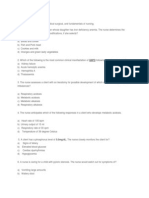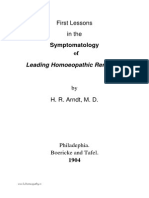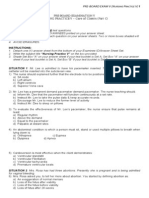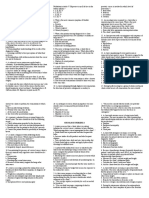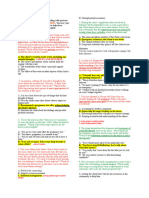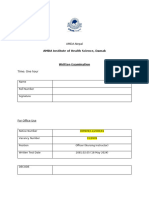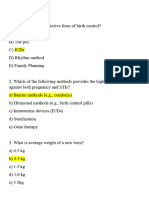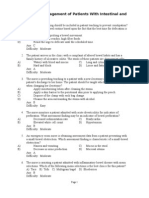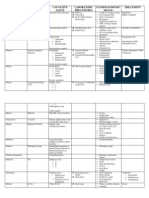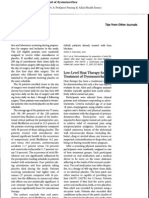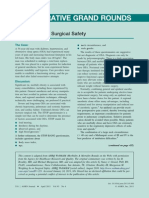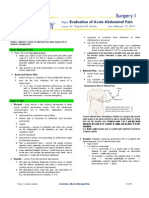Pre-Board IV
Pre-Board IV
Uploaded by
AiCopyright:
Available Formats
Pre-Board IV
Pre-Board IV
Uploaded by
AiOriginal Description:
Original Title
Copyright
Available Formats
Share this document
Did you find this document useful?
Is this content inappropriate?
Copyright:
Available Formats
Pre-Board IV
Pre-Board IV
Uploaded by
AiCopyright:
Available Formats
PRE-BOARD EXAM IV (NURSING PRACTICE IV) 1 PRE-BOARD EXAMINATION IV NURSING PRACTICE IV Care of Clients (Part B)
GENERAL INSTRUCTIONS: 1. This test booklet contains 100 test questions. 2. Read INSTRUCTIONS TO EXAMINEES printed on your answer sheet. 3. Shade only one (1) box for each question on your answer sheets. Two or more boxes shaded will invalidate your answer. 4. AVOID ERASURES. INSTRUCTIONS: 1. Detach one (1) answer sheet from the bottom of your Examinee ID/Answer Sheet Set. 2. Write the subject title Nursing Practice IV on the box provided. 3. Shade Set Box A on your answer sheet if your test booklet is Set A; Set Box A on your answer sheet if your test booklet is Set A; Set Box B if your test booklet is Set B.
SITUATION 1: Man develops within the culture of his society, which strongly influences his health beliefs, values and behaviors patterns. 1) Which factor most affect the course of ones illness: a) Competence of care given b) Attitudes and feelings c) Educational level d) Previous hospital experience 2) A persons responses to health and illness are culture specific based on: a) Support of Family and significant others b) Ones experience and perception of health c) Availability and accessibility of health services d) Influence of social norms 3) Health promotion behaviors are those that enhance. a) Optimum functioning b) Quality of life c) Healthy functioning d) Social and productive life 4) The following statements on a personal persons response to crisis is true: a) One does not generally face a crisis alone b) Success in coping with crisis can be learned c) A situation maybe a crisis for one but not for another d) All of these
PRE-BOARD EXAM IV (NURSING PRACTICE IV) 2 5) In recent years the government have more emphasis which of the following a) Rehabilitation b) Treatment of disease c) Preventing of illness d) Treatment and rehabilitation SITUATION 2: Mrs. Violy 38 years old complaints of chest pain and she was admitted in the Medical Emergency Hospital. 6) How will you assess angina pectoris? a) Subinternal chest pain b) Stabbing c) Crushing chest pain d) Vertigo on standing 7) In stages of hypertension stage 3 is described as> a) Systolic 140 159; diastolic 90 99 b) Systolic 180 209; diastolic 110 119 c) Systolic 160 179; diastolic 100 109 d) Systolic equal to or greater than 210; diastolic equal to or greater than 120 8) Drugs for M.I. a) Nitro glycerine b) Demerol
c) Ponstan d) Morphine
9) Levines sign is define as: a) Pain radiating to the left shoulder and arm, jaw, epigastric area. b) Clients clenches first over a few minutes of rest c) Generally subsides after a few minutes of rest d) Crushing or pressure pain 10) a) b) c) d) The least complication will occur in coronary occlusion is: Congestive heart failure Hypertensive Ventricular fibrillation Cardiac arrest
SITUATION 3: The Public health Nurse conducts heath education classes to the group of high school students in Barangay Babak. 11) A period at which menses begin is called: a) Menstruation b) Sexual development c) Menarche d) Sex maturation 12) a) b) c) d) 13) a) b) The normal sperm characteristics. Big head, long tail, pearly white Big head, short tail, yellowish Small heads, long tails, white Small heads, long tail, pearly white The average P.H. of a sperm is: 7.2 c) 6.0 7.5 d) 6.8
PRE-BOARD EXAM IV (NURSING PRACTICE IV) 3 14) The average amount of semen released during ejaculation is. a) 2 to 3 ml c) 5 to 6 ml. b) 3 to 5 ml d) 60 to 10 ml. 15) Variations in the length of the menstrual cycle are due to the variations in the numbers of days in the: a) Follicular phase c) Ischemic phase b) Luteal phase d) Secretory phase SITUATION 4: Irene 39 years old was admitted because of a mass the size of a 5centavo on the lower quadrant of her left nipple. 16) You advice her to breast self-examination. The optimal time to encourage regularly and routine BSE on Irene is: a) 8th day of the menstrual cycle b) 5th day of the menstrual cycle c) 8th day of every month d) 1st day of every month 17) a) b) c) d) On palpation you observe that the mass is movable this is indicative of: Benign tumor Malignant tumor Spread of cancer cells Invasion of cancer cells
18) Diagnostic examination for breast cancer before its clinically palpable is: a) Frozen section c) X-ray of the breast b) Galactography d) Mammography 19) Most common sites of metastasis is/are; EXCEPT: a) Bone marrow c) Lungs b) Brain d) Heart 20) a) b) c) d) Radical mastectomy is the removal of: Breast, pectoral muscles pectoral fascia and nodes Breast, pectoral fascia and nodes Breast and nodes only Lump and surrounding breast tissue
SITUATION 5: Anacleto 18 years old has just graduated from high school and he got a scholarship in the College entrance test after the routine medical examination he was diagnosed to have Hepatitis-B. 21) How could you explain to him about his situation? a) Anacleto you have Hepatitis-B b) Inform his parents c) You are out of your scholarship d) Refer him to the Doctor 22) The incubation period of Hepatitis B is: a) 15 to 50 days c) 10 to 15 days b) 50 to 90days d) 3 to 5 days
PRE-BOARD EXAM IV (NURSING PRACTICE IV) 4 23) a) b) c) d) 24) a) b) c) d) Hepatitis-B virus is transmitted through. Contaminated syringe and needles Eating raw fruits and vegetables Contaminated food and water Droplets from throat and carrier Hepatitis-B vaccination is given as follows: 2 doses at 3 weeks interval 2 doses at 4 weeks interval 3 doses at 4 weeks interval 3 doses at 3 weeks interval
25) Hepatitis-B vaccinations have been incorporated with the plans of the EPI. The main target for this vaccination are the: a) New born and infants b) Carriers c) School children d) Pre-schoolers SITUATION 6: Mr. Duhaylungsod was brought to the ER complaining of pain located in the upper abdomen. Diagnosis is peptic ulcer. 26) A frequent discomfort experience by the client due to his peptic ulcer is: a) Nausea c) Vomiting b) Diarrhea d) Eructation 27) a) b) c) d) The purpose of dietary treatment of the client is to: Neutralize the free HCL in the stomach Delay gastric emptying Prevent constipation Delay surgery
28) Diet is an important factor in the treatment of the peptic ulcer which is: a) Sippy c) Bland b) Liquids d) Frequent meals 29) a) b) c) d) 30) a) b) c) d) Which of this diagnostic measure is NOT indicated for the client: Gastric analysis Gastrointestinal Patients history X-ray of the abdomen Antacids are administered to the client to: Tranquilize the intestine Lower the acidity of gastric secretions Aid in digestion Decrease gastric motility
SITUATION 7: Mrs. Martha Trazo, sought consultation due to indigestion following ingestion of fatty, fluid and gas-forming foods causing an upper abdominal pain. The admitting diagnosis is cholecstitis with cholelithiasis. 31) Ingestion of fatty foods may precipitate upper abdominal pain, this is cause by: a) Fats in the duodenum which increases gastric secretions
PRE-BOARD EXAM IV (NURSING PRACTICE IV) 5 b) Fats in the duodenum content initiates the reactions which causes gallbladder contraction c) Fatty foods are difficult to digest which causes gallbladder contraction d) Fatty foods initiates gastric secretions 32) Mrs. Martha Trazo is experiencing pruritus in the lower extremities, what is the most helpful in relieving the discomfort. a) Massaging with isopropyl alcohol b) Rubbing with face towel c) Applying weak sodium bicarbonate d) Using liberal babys oil and talcum powder 33) a) b) c) d) The reason for the clay colored stool for a client with cholelithiasis is: Decrease of bacterial flora of the bowel Obstruction of the bile flow to the gallbladder Interference in the absorption of proper nutrients Obstruction in the bile flow to the bowel
34) Mrs. Trazo underwent cholecytectomy and choledochotomy and a T-tube in place. To evaluate the effectiveness of the T-tube, the nurse should understand that the primary reason for using it with this client is to: a) Promote wound drainage b) Provide a way to irrigate the biliary act c) Minimize the passage of bile into the duodenum d) Prevent bile from entering the peritoneal cavity 35) How much bile would the nurse expect the T-tube to drain the first 24 hours after surgery? a) 50-100 ml c) 300-500 ml b) 150-250 ml d) 550-700 ml SITUATION 8: Leonardo, a 3 week-old infant is brought to the by his parents. His mother state he has been crying almost constantly since birth and frequently draws his knees up to his abdomen. Colic is suspected. 36) Which of the following assessment findings would be consistent with a diagnostic of colic? a) Frequent vomiting b) Soft abdomen c) Expulsion of flatus d) Failure to gain weight 37) a) b) c) d) Which of the following is a preventive measure for colic attacks? Give oral antispasmodic Insert rectal tube gently Let him lie on his abdomen after feeding Burped frequently during and after feeding
38) The nurse asks the parents to describe the infants bowel movements. Which of the following descriptions would the nurse expect if the infant does indeed have colic. a) Mucus-like stools b) Ribbon-like stools c) Frequent watery stools d) Soft, yellow stools
PRE-BOARD EXAM IV (NURSING PRACTICE IV) 6 39) a) b) c) d) 40) a) b) c) d) Which of the following would not provide pertinent diagnostic data about colic? The position of the infant during burping The use of an infant high chair The infants crying pattern The amount of formula given the infant The nurse performs the following to determine the familys nursing problems. Goal setting Family health care plan formulation Assessment Evaluation
SITUATION 9: Mr. Camilo, 55 years old, is complaining of pain in his left leg. A diagnosis of intermittent claudication is made. 41) The following Diagnostic exam is considered. a) Arteriogram c) Phlebography b) Encephalography d) Doppler flow rate 42) Heparin IV is ordered to Mr. Camilo at the rate of 1,000 U per hour. The concentration of heparin solution is 12,500 U of heparin in 250 ml. Of 0.9 % Nacl. The nurse set to deliver the amount per hour. a) 12 ml c) 25 ml b) 20 ml d) 50 ml 43) All of the following are drugs of choice for leg cramps, EXCEPT: a) Calci-aid c) Calpol b) Cal-pcede d) Calcebone 44) During Heparin therapy monitors the following: a) APTT c) BT b) PT d) CT 45) a) b) c) d) Nursing intervention for the diagnosed with peripheral vascular disease include: Providing and teaching about [roper foot care Warning against alcohol ingestion Promoting a low residue diet Encouraging the use of heavy support stocking
SITUATION 10: Estong, age 52, is referred for treatment of severe obsessivecompulsive disorder. 46) Mario has a compulsive ritual of washing his hand 25 times before he eat his meals. Which of the following nursing interventions is most helpful? a) Suggest that he begins his ritual earlier b) Prohibit Estong from carrying out meal ritual c) Discuss his ritualistic behavior with him 47) a) b) c) d) 48) Estong will not be able to stop handwashing ritual until he: Acquires more super ego strength Can manage his feeling of anxiety Recognize that behavior is unrealistic Regains contact with reality A relevant nursing diagnosis is:
PRE-BOARD EXAM IV (NURSING PRACTICE IV) 7 a) b) c) d) Ineffective individual coping Self esteem disturbance Social isolation Altered throughout process
49) In formulating a plan of care focused on decreasing Estongs anxiety, the nurse should: a) Work with him to develop limits on the behavior b) Discourage him from performing the rituals c) Ignore the ritualistic activities d) Help him regain self control 50) The ego defense mechanism, which are commonly utilized in obsessive compulsive disorder are. a) Displacement and undoing b) Suppression and projection c) Sublimation and introjections d) Rationalization and repressions SITUATION 11: Mrs. Maacap a newly-married couple, plan to start a family only after at least a year of adjustment. They want to practice family planning. 51) Mrs. Maacap is interested is IUD. You tell her that its insertion is usually done at this period of the menstrual cycle. a) 1st to 4th days b) 7th to 10th days c) 12th to 16th days d) 18th to 20th days 52) You introduce to the couple to the cervical mucus method. That intercourse is discourage when cervical secretion is: a) Whitish and thin b) Cloudy and viscous c) Yellowish and thick d) Clear and stretchable 53) You also explain to them the basal body temperature method, in which the fertility period surrounding ovulation usually extends from. a) 5 hours before to 10 hours after ovulation b) 10 hours before to 96 hours after ovulation c) 24-48 hours before to 48 hours after ovulation d) 72 hours before and 72 hours after ovulation 54) Another commonly used birth control method if the Pills. The oral contraceptive prevent pregnancy by: a) Rendering the spermatozoa inactive b) Preventing ovulation c) Prevent implantation d) Prevent fertilization
PRE-BOARD EXAM IV (NURSING PRACTICE IV) 8 55) This is used to prevent transmission of STDs. a) Condom c) Rhythm method b) IUD d) Billings Method SITUATION 12: Katherine, 14 years old Junior high school student sexually assaulted by five men. 56) The common initial reaction to sexual assault is: a) Increased anxiety b) Difficulty in concentrating c) Difficulty indecision making d) Shock, numbness and disbelief 57) Katherine, verbalizes to her mother and the Nurse, I feel so dirty. I feel so ashamed. The most appropriate response to the nurse is: a) You should have fought back b) There is nothing to be ashamed of, people would not know c) You have a terrible experience, Do you like to talk about it d) Why do you feel so dirty? 58) When Katherine expressed feelings of ashamed or self blame, the appropriate nursing intervention is: a) Remain neutral, non-judgmental and assure her of confidentiality b) Bring with her a private place night away c) Stay with her during the physical examination d) Tell her that those are common reactions experienced by victims of sexual assault 59) Katherine cries helplessly while being comforted by her mother. As a nurse, you would say to her. a) Be calm, it will help you see through your problem b) It must really be disturbing to be in your situation c) Ill go see a doctor so he can prescribed a drug to calm you d) Ill leave you to your mother and come back when you are comfortable already 60) During the initial phase of crisis, an appropriate of crisis, an appropriate nursing intervention to help Katherine is: a) Providing an environment to meet her current psychological needs b) Focusing on rape crisis situation rather than previous problems c) Attending to her physical needs d) Helping her take shock of her life prior the crisis SITUATION 13: Mr. Harimon, 42 years old, a police officer has been diagnosed as not slept for 2 months. 61) Which of the following would be the most appropriate initial intervention by the nurse, when she saw my. Harimon, restless and walking around the room who seems to be anxious. a) Lets sit down and watch T.V b) Would you like to tell me about what makes you so anxious c) You look very anxious, what are you experiencing right now d) I will walk with you might probably want to tell something 62) In assessing Mr. Harimon coping style. The nurse asks the following question. a) What would you like to discuss
PRE-BOARD EXAM IV (NURSING PRACTICE IV) 9 b) c) d) 63) a) b) What are you thinking about Does it seems life is meaningless to you What do you think, you could do help in your situation He is prescribes with lithium carbonate adequate fluid intake is: 1,000 ml/day c) 2,000 ml/day 1,500 ml/day d) 3,000 ml/day
64) The therapeutic serum lithium level in adult is: a) 1.0 to 2.0 Meg/L c) 1.0 to 2.5 Meg/L b) 0.5 to 1.5 Meg/L d) 0.8 to 1.8 Meg/L 65) Which of the following characteristics of hyperactive client can be used by nurse to direct his activities? a) Flight of ideas b) Emotional liability c) Distractibility d) Delusions of grandiosity SITUATION 14: Mr. Simon, 28 years old was rushed to the hospital due to burns sustained from a movie house. 66) The initial nursing management upon admission in the ER is: a) Assess airway, breathing and circulation b) Vita signs c) Administer oxygen therapy d) Apply antimicrobial cream over burned are. 67) The nurse inserts an indwelling urinary catheter. The rationale for this action is to help. a) Decrease the workload of the kidneys b) Ensure adequate urine output measurement c) Obtained regular urine specimens d) Prevent urine retention 68) A priority nursing diagnosis category for Mr. Simon during the emergent period would be. a) Fluid volume excess b) Altered nutrition; less the body requirements c) High risk for urine falls d) High risk for infection 69) While caring for MR. Simon with a burn injury, the nurse should observe for signs and symptoms of which complication believed to be due primarily to stress. a) Injection b) Gastric dilatation c) Nitrogen imbalance d) Hourly urine specific gravity 70) During the first 48 72 hours following a major burn injury. IV infusion rate will be adjusted by evaluating Mr. Simons. a) Daily body weight c. b) Hourly body temperature c) Hourly urine output d) Hourly urine specific gravity
PRE-BOARD EXAM IV (NURSING PRACTICE IV) 10 SITUATION 15: Mrs. Lloren, 60 years of age, fell and fractured her right femur. 71) In the hospital she was placed on Bucks extension in order to: a) Reduce swelling b) Strengthen involved muscles c) Reduced the fracture d) Shorten the time required for healing 72) Following interval fixation. The clients legs should be positioned: a) Inflexion c) Abduction b) In adduction d) Inflexion at the hip 73) a) b) c) d) 74) a) b) c) d) The following statements are true about Russell traction: It permits bending at the knees It can apply only unilaterally It may contribute to severe pain No freedom of motion Nursing measures to prevent pneumonia post-operatively: Turn her to sides every shift Turn her to sides every 6 hours Turn her contribute to severe pain Turn her to sides every 2 hours
75) The doctor ordered 1-liter ofdD50Rs to be given in 6 hours. How many drops should the nurse regulate the flow of IV fluids per minutes a) 55 gtts/min c) 33 gtts/min b) 42 gtts/min d) 22 gtts/min SITUATION 16: Samuel, 40 years old was brought to the mental health Rehab.Center after a history of physically abusing his wife every time he is intoxicated. 76) Initial assessment upon admission would help the nurse identify one of the following as the clients problem a) In effective individual coping b) Disturbance in self-esteem c) Impaired social interaction d) Altered health maintenance 77) During a nurse-client interaction, Samuel says, Alcohol made it. This is an example of what defense mechanism. a) Rationalization b) Sublimation c) Displacement d) Altered health maintenance 78) The psychotherapy most appropriate to Mr. Samuel, sine the family members is affected. a) Milieu therapy c) Family therapy b) Group therapy d) Behavior therapy 79) Drug of choice for Alcoholics is / are: a) Disulfiram c) Valium b) Lithium carbonate d) Thorazine
PRE-BOARD EXAM IV (NURSING PRACTICE IV) 11 80) Nursing interventions which can help Samuel rebuild trust in his relationship with his wife. a) Allow his wife to visit regularly b) Refers him to a marriage counselor c) Encourage them to attend a marriage encounter seminar d) Encourage him to verbalize his concerns to his wife
SITUATION 17: These questions pertain to child growth and development. 81) At what age proper tooth brushing should be imposed: a) Weaning b) Post 2 years old c) Star of school age d) Before 4 months to 2 years old 82) At what age do concepts of reversibility and cause and effect develop? a) 5 to 7 years c) 6 to 12 years b) 3 to 5 years d) 1 to 3 years 83) To properly visualize the auditory canal a 4 year old during an otoscopic examination. The nurse should pull the pinna of the ear. a) Up and back c) Down and back b) Up and forward d) Down and forward 84) a) b) c) d) 85) a) b) c) d) The most appropriate toy is s for 6 month old infant would be: Push-pull toys Wooden blocks Soft stuffed animals Shape matching toys A developmental assessment of a 9 month old would be expected to reveal. A two-to three word vocabulary An ability to feed self with a spoon The ability to sit steadily without support Closure of both anterior and posterior fontanels
SITUATION 18: Nichole Victoria, Mutya ng Davao is admitted to the Community mental Hospital and she diagnosed as having anorexia nervosa. 86) Anorexia Nervosa is usually precipitated by: a) The acting out of aggressive impulses, which results in feelings of hopelessness b) An unconscious wish to punish a parent who tries to dominate the adolescent life c) The inability to deal with being the center of attention in the family and a desire for independence d) An inaccurate perception of hunger stimuli and a struggle between dependence and independence 87) a) b) c) d) To obtain information for the nursing history Nicholes history is likely to reveal. Strong \desire to improve her self-image A close, supportive mother-daughter relationship Low achievements in school., with little concern for grades Satisfaction with and a desire to maintain her present weight
88) a) b) c) d) 89) a) b) c) d) 90) a) b) c) d)
PRE-BOARD EXAM IV (NURSING PRACTICE IV) 12 The nursing intervention that should receive the highest priority is: Provide adequate rest and nutrition Monitoring the clients fluid and electrolyte balance Completing an assessment of the clients mental status Obtaining more data about the clients diet and exercise program When interacting with Nichole, the Nurse should. Show empathy Maintain control Set and maintain limits Focus on dietary nutrition One day, Nichole starts to discuss food and eating, the nurse should plan to: Tell her gently but firmly to direct all discussion of food to the dietician Use her current interest in food to encourage her to increase her intake Listen closely to determine her favorite foods and secure these foods for her Let her talk about foods as long as she wants, but limit discussion about her eating
SITUATION 19: For professional development, it is a policy of nursing service to encourage nurses to participate on the improvement of nursing practice. 91) When you participate in nursing research you main activity is to: a) Solve a nursing problem b) Develop problem-solving skills c) Explain a nursing phenomenon d) Understand man as human being 92) a) b) c) d) Which of the following would you do first? Ask an attendant to help you Attend first to pts. With watchers Attend first to pts. With watchers Organize activities by priority
93) After one year, Mrs. Monreal was rotated to the OR. As OR nurse, she was ordered by the obstrician to give spinal anesthesia because the anesthesiologist was rate. The nurse should. a) Give the anesthesia, if the Doctor writes the order b) Give the anesthesia, if the supervising nurses allows it c) Give the anesthesia, if the Obstetrician supervises her d) Never given the anesthesia 94) When a physician gives a telephone order, the only way for the order to be legal is. a) The physician must give his name over the phone b) The nurse record the order in the Treatment Sheet c) The physician must sign the order within the prescribed time d) The supervisor must accept the phone order 95) a) b) c) d) This is the best course of action when faced with ethical difficulties: Discuss with a lawyer Assess the ethical problem in question Reflect on your conscience Refer to spiritual group
PRE-BOARD EXAM IV (NURSING PRACTICE IV) 13
SITUATION 20: Mr. Santiago is admitted for cardiac catherization: 96) In taking care of clients for cardiac catherization, the nurse noted that the client manifested fear to the procedure and its outcome. This statement is an example of: a) Nursing diagnosis b) Implementation c) Assessment d) Evaluation 97) When caring for Mr. Santiago after cardiac catherization. It is most important that the nurse: a) Provide for rest b) Administer oxygen c) Check the ECG every 30 minutes d) Check pulse distal to the insertion site 98) Mr. Santiago is receiving anticoagulants; the nurse care should include observations for. a) Nausea c) Headache b) Epitaxis d) Chest pain 99) a) b) c) d) 100) a) b) c) d) The nurse is aware that the Bradycardia means. A grossly irregular heartbeat A heart of over 90 / min. A heart rate of under 60 / min A heart beat that has regular skipped beats Youre monitoring the CVP line every 2 hours. You are aware that: A normal reading is 60 to 120 mm of water A high reading maybe indicative e of hydration The zero point of the manometer is level with mid axilla The client must be kept flat in bed while the catheter is in place
***END***
You might also like
- Community Health Nursing Astig NurseDocument4 pagesCommunity Health Nursing Astig NurseKristine Singson100% (1)
- 2021 July Compilation 1Document198 pages2021 July Compilation 1John WallaceNo ratings yet
- Williams Gynecology PDFDriveDocument25 pagesWilliams Gynecology PDFDriveKawaii Rjen-chan100% (1)
- Sample Saudi Council ExamDocument10 pagesSample Saudi Council Examvinwaleed100% (2)
- NLE Compilation 1Document67 pagesNLE Compilation 1blazegomez91% (34)
- Pre-Board IDocument10 pagesPre-Board IAi100% (1)
- Romany Herbal RemediesDocument51 pagesRomany Herbal RemediesAmber McDonald100% (1)
- Final Coaching NP4 Set 2Document18 pagesFinal Coaching NP4 Set 2STEFFI GABRIELLE GOLEZNo ratings yet
- Pre-Board IIIDocument7 pagesPre-Board IIIAiNo ratings yet
- Arndt - First Lessons in Symptomatology of Leading Homeopathic RemediesDocument85 pagesArndt - First Lessons in Symptomatology of Leading Homeopathic Remediesaruen79No ratings yet
- Preboard NP VDocument11 pagesPreboard NP VAiNo ratings yet
- Nursing Practice IVDocument11 pagesNursing Practice IVapi-3718174100% (1)
- NP2Document12 pagesNP2mhamaenphapa27100% (2)
- Np4 np5Document71 pagesNp4 np5Erika SapieraNo ratings yet
- NLE Pre-Board December 2007 Practice 1Document13 pagesNLE Pre-Board December 2007 Practice 1Aijem RyanNo ratings yet
- NP4Document31 pagesNP4Kenny NadelaNo ratings yet
- RECALL 6 np2Document24 pagesRECALL 6 np2shiplusNo ratings yet
- PNLE V Nursing PracticeDocument10 pagesPNLE V Nursing PracticeASDF ASDF100% (2)
- Nle 2015 QuestionsDocument4 pagesNle 2015 QuestionsJona Suarez100% (1)
- 2008 NP4Document11 pages2008 NP4Jeremiash Noblesala Dela CruzNo ratings yet
- NP3 Nursing Board Exam December 2006 Answer Key 'Nursing Care of Client With Physiological and Psychosocial Alteration'Document13 pagesNP3 Nursing Board Exam December 2006 Answer Key 'Nursing Care of Client With Physiological and Psychosocial Alteration'Marjorie RefuerzoNo ratings yet
- Nursing Questions& AnswersDocument42 pagesNursing Questions& AnswersSanjeev Kumar100% (1)
- PNLE Comprehensive 3Document24 pagesPNLE Comprehensive 3Zyla MalinaoNo ratings yet
- MSDocument17 pagesMSJonas Marvin AnaqueNo ratings yet
- Rationale: A Leader Doesn't Have Formal Power and Authority But Influences The SuccessDocument32 pagesRationale: A Leader Doesn't Have Formal Power and Authority But Influences The SuccessJohn kananamanNo ratings yet
- Nursing Test 2 (NP I)Document9 pagesNursing Test 2 (NP I)Yuxin LiuNo ratings yet
- CHN&CDDocument7 pagesCHN&CDDharline Abbygale Garvida AgullanaNo ratings yet
- PNLE June 2007 With Key AnswersDocument82 pagesPNLE June 2007 With Key AnswersJustin CubillasNo ratings yet
- CHN QuestionsDocument10 pagesCHN QuestionsHerne BalberdeNo ratings yet
- July PNLE 2011 PreBoard ExamDocument9 pagesJuly PNLE 2011 PreBoard ExamRon KimNo ratings yet
- Nursing Test 3 (NP Ii)Document16 pagesNursing Test 3 (NP Ii)Yuxin LiuNo ratings yet
- PNLE COMPILED REVIEWERS 8 PartsDocument226 pagesPNLE COMPILED REVIEWERS 8 PartserineunicerosaryNo ratings yet
- PNLE: Community Health Nursing Exam 5 - RNpediaDocument13 pagesPNLE: Community Health Nursing Exam 5 - RNpediaLot RositNo ratings yet
- Ucu Iii Post Test July 4 2023 RatioDocument74 pagesUcu Iii Post Test July 4 2023 RatioVince C. Matamis100% (1)
- PB2 NP3Document21 pagesPB2 NP3shiplusNo ratings yet
- Git OnlineDocument82 pagesGit OnlineCarl JustineNo ratings yet
- Fearless Forecast Nle 2019Document12 pagesFearless Forecast Nle 2019Mee AmorèNo ratings yet
- 2021 July Compilation W AnswersDocument115 pages2021 July Compilation W Answersdandandandalandan 2No ratings yet
- NP5 Recall - Pre-IntensiveDocument10 pagesNP5 Recall - Pre-IntensiveTristan CamilonNo ratings yet
- Palmer Set 4Document8 pagesPalmer Set 4Jes CmtNo ratings yet
- Document 102Document12 pagesDocument 102Marie JhoanaNo ratings yet
- PsychiaDocument12 pagesPsychiaLloyd Rafael Estabillo100% (1)
- ASTIG NURSE TOPIC 22 To 29Document7 pagesASTIG NURSE TOPIC 22 To 29Freddie BulsaraNo ratings yet
- Set 2 PDFDocument28 pagesSet 2 PDFAlyssa MontimorNo ratings yet
- Nursing Practice I EdgeworthDocument8 pagesNursing Practice I EdgeworthRichard Ines Valino100% (5)
- QuestionsDocument31 pagesQuestionsEric Matig-a EbradaNo ratings yet
- June 2007 PnleDocument149 pagesJune 2007 PnleDarwin Jhon Hernal0% (1)
- Oncology Nursing WorkbookDocument3 pagesOncology Nursing WorkbookZhy CaluzaNo ratings yet
- Nursing Test 3 (Np-I)Document20 pagesNursing Test 3 (Np-I)Yuxin LiuNo ratings yet
- ERDNDocument128 pagesERDNJohiarra Tabigne100% (1)
- Erdn PostDocument9 pagesErdn PostKiahana PascualNo ratings yet
- MS 1Document20 pagesMS 1Bonieve Pitogo NoblezadaNo ratings yet
- NP5 Recalls7Document11 pagesNP5 Recalls7AhrisJeannine EscuadroNo ratings yet
- NP1 NotesDocument6 pagesNP1 NotesGrace TangoNo ratings yet
- Nursing Test 1 (NP V)Document9 pagesNursing Test 1 (NP V)Paul Nathan BetitaNo ratings yet
- B1. Fundamentals - 50item With Rationale IDocument8 pagesB1. Fundamentals - 50item With Rationale IBlardy Falking You Benchod BlardyNo ratings yet
- NLE NP1 QuestionsDocument39 pagesNLE NP1 Questionsrenzydelacruz9No ratings yet
- Funda Prof - Ad LMR AnswersDocument35 pagesFunda Prof - Ad LMR AnswersFreeNursingNotesNo ratings yet
- NP1 Dec 2006 NLEDocument16 pagesNP1 Dec 2006 NLElibrebuk23100% (1)
- Pnle MCN and PediatricsDocument24 pagesPnle MCN and PediatricstrashnijairoNo ratings yet
- MCQ NoDocument14 pagesMCQ NoSarita RawalNo ratings yet
- Qatar Prometric ReviewerDocument7 pagesQatar Prometric ReviewerValerieOchavoNo ratings yet
- CHN 1 HighlightedDocument17 pagesCHN 1 HighlightedAsad MirajNo ratings yet
- Chapter 38 - Management of Patients With Intestinal and Rectal DisordersDocument7 pagesChapter 38 - Management of Patients With Intestinal and Rectal DisordersMichael BoadoNo ratings yet
- Coc Exam Sept 2014 Paper 2Document33 pagesCoc Exam Sept 2014 Paper 2Lewis KinyuaNo ratings yet
- Diagnosis Other Name Causative Agent Laboratory Procedures Pathognomonic Sign (S) TreatmentDocument4 pagesDiagnosis Other Name Causative Agent Laboratory Procedures Pathognomonic Sign (S) TreatmentAiNo ratings yet
- Pokemon EmeraldDocument2 pagesPokemon EmeraldTedNo ratings yet
- BON ForteDocument1 pageBON ForteAiNo ratings yet
- December2012nletips Funda 121005040112 Phpapp02 PDFDocument6 pagesDecember2012nletips Funda 121005040112 Phpapp02 PDFJessamine Rochelle Reyes EsbertoNo ratings yet
- Psychiatric NursingDocument12 pagesPsychiatric NursingAiNo ratings yet
- Catechism For Filipino Catholics BookDocument513 pagesCatechism For Filipino Catholics BookPaul Pineda93% (14)
- Behavioral VerbsDocument3 pagesBehavioral VerbsMaya MalanumNo ratings yet
- Heat (2001)Document2 pagesHeat (2001)AiNo ratings yet
- Intelligent DesignDocument10 pagesIntelligent DesignAiNo ratings yet
- Psychiatric NursingDocument42 pagesPsychiatric NursingAiNo ratings yet
- Weighing inDocument3 pagesWeighing inAiNo ratings yet
- 100 Item MEDICAL SURGICAL Nursing ExaminationDocument18 pages100 Item MEDICAL SURGICAL Nursing ExaminationAijem Ryan100% (1)
- Intestinal ObstructionDocument157 pagesIntestinal ObstructionOmar SuleimanNo ratings yet
- Assessing Pain in Horses: Karina Bech GleerupDocument7 pagesAssessing Pain in Horses: Karina Bech GleerupCristina GMNo ratings yet
- Shalya August 2021 17 Batch Unitised SyllabusDocument4 pagesShalya August 2021 17 Batch Unitised Syllabussourabh nandagaveNo ratings yet
- Acute Abdominal Pain Intern DR Shamol PrintDocument12 pagesAcute Abdominal Pain Intern DR Shamol PrintmaybeNo ratings yet
- Fect Eau 2017Document15 pagesFect Eau 2017Allison DiêgoNo ratings yet
- Understanding The Anatomy of The Equine Gastrointestinal TractDocument4 pagesUnderstanding The Anatomy of The Equine Gastrointestinal TractMikael QueirozNo ratings yet
- Presentasi COLON AND RECTUM INJURY, DR - Agus Barmawi, SP.BDocument20 pagesPresentasi COLON AND RECTUM INJURY, DR - Agus Barmawi, SP.BesterhsNo ratings yet
- Thibault 2019Document8 pagesThibault 2019Mafe HerreraNo ratings yet
- Introduction To Sample QuestionsDocument24 pagesIntroduction To Sample QuestionsmtassyNo ratings yet
- Homeopathy in Practice - Borland, Douglas, D. 1960Document198 pagesHomeopathy in Practice - Borland, Douglas, D. 1960Ngaimuankim valteNo ratings yet
- ANALGIN 30% Injectable Solution: Intravenously (Slowly), IntraperitoneallyDocument1 pageANALGIN 30% Injectable Solution: Intravenously (Slowly), IntraperitoneallyAleksandar ParamatmanNo ratings yet
- Horse HerniaDocument2 pagesHorse HerniaHadi Putra RihansyahNo ratings yet
- Chapter 15 - Abdominal PainDocument8 pagesChapter 15 - Abdominal Pain2qmvdb59jdNo ratings yet
- (Pharmacology) Antispasmodic DrugsDocument11 pages(Pharmacology) Antispasmodic Drugsairon jakeNo ratings yet
- The Analgesic Effect of Ketorolac Addition For Renal Colic PainDocument5 pagesThe Analgesic Effect of Ketorolac Addition For Renal Colic PainNovi KurniaNo ratings yet
- MCQs (Medicine)Document55 pagesMCQs (Medicine)Ibrar FaisalNo ratings yet
- AbdomenDocument23 pagesAbdomenjnyamusiNo ratings yet
- Fieldguide To Toxic Plants in AustraliaDocument132 pagesFieldguide To Toxic Plants in AustraliaZnoishta NejadkayNo ratings yet
- Evaluation of The Adult With Abdominal Pain - UpToDateDocument13 pagesEvaluation of The Adult With Abdominal Pain - UpToDateAudricNo ratings yet
- Case Report: Gastrointestinal Stromal Tumor in The Cecum of A HorseDocument6 pagesCase Report: Gastrointestinal Stromal Tumor in The Cecum of A HorsePrimyntNo ratings yet
- Acute Abdomen and PeritonitisDocument17 pagesAcute Abdomen and PeritonitisAgatha Billkiss IsmailNo ratings yet
- Foeniculum Vulgare Assessment ReportDocument23 pagesFoeniculum Vulgare Assessment ReportRamya MCNo ratings yet
- Diagnosis and Acute Management of Suspected Nephrolithiasis in Adults - UpToDateDocument44 pagesDiagnosis and Acute Management of Suspected Nephrolithiasis in Adults - UpToDateManu Luciano100% (1)
- Evaluation of Acute Abdomen 2013ADocument4 pagesEvaluation of Acute Abdomen 2013AEdison Tan SantamariaNo ratings yet
- Surgical Management of Abomasal DiseaseDocument16 pagesSurgical Management of Abomasal DiseaseAbdul MajeedNo ratings yet
- Acute AbdomenDocument69 pagesAcute AbdomenArwa Qishta100% (1)
- Abdominal PainDocument19 pagesAbdominal PainAudricNo ratings yet



